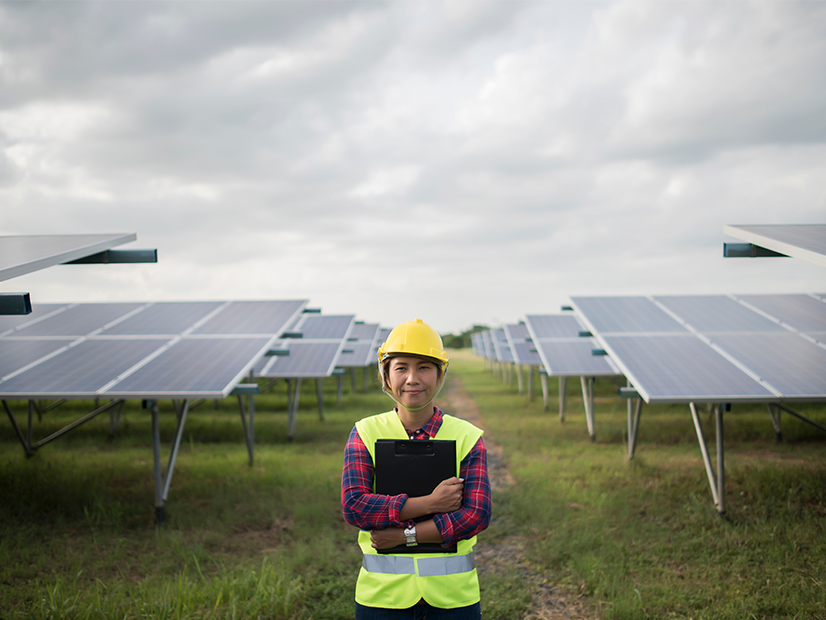
Creating a truly diverse, equitable and inclusive workforce for the coming clean energy economy will require a shift in how companies currently perceive talent.
“We make assumptions about people based off what they look like, their identity or their background, but we also make assumptions about people based off of what they’ve done before,” Natalie Edwards, global diversity officer at National Grid (NYSE:NGG), said Thursday at the New England Women in Energy and the Environment (NEWIEE) 2021 Women Shaping the Agenda event.
If someone is a utility line worker, for example, there’s a tendency to think that person will be a line worker forever, she said.
“We have to check our assumptions, which are biases about what we think is possible for the people around us,” she said, adding that it’s imperative for businesses to see their workforce and potential talent candidates “as having infinite possibility.”
National Grid has one of the most female leadership teams in the energy industry, and some of its business units have more women on the leadership team than men, according to Edwards.
The company has commissioned research that will help the industry understand how bringing “women to the table, particularly leadership, ties to” achieving net-zero emissions, she said. “We know having more women at the table leads to more innovation, and it’s time for us to prove it and tie it to energy results.”
Senior and leadership levels of energy companies are not diverse in terms of race or gender, Annelies Goger, a David M. Rubenstein Fellow in the Brookings Metropolitan Policy Program, said during the event.
Women make up 25% of the energy workforce and 47% of the general labor force, while only 8% of the energy workforce is black and 16% is Latino or Hispanic.
“Diversity and inclusion isn’t just about hiring people into a job,” Goger said. “It’s about creating pathways into leadership both within the organization and also allowing opportunities for people to transfer to do something different.”
Federal Support
Support at the federal level for a diverse energy workforce is coming from a fresh approach to job creation within the U.S. Department of Energy.
“Part of what we’re looking to do is not recreate existing inequities in our energy system, both in terms of where we are generating our energy, and in terms of who is working on our energy,” said Jennifer Jean Kropke, director of energy jobs at DOE.
The Office of Jobs, she said, is thinking about labor standards as a way to help transition equitably to a clean energy workforce. That approach might include attaching labor standards to funding streams, she said. Her office, she added, also is educating other DOE offices on the power of collective bargaining agreements for the industry.
“With entities like unions, there are clear pipelines in place to make sure that we are getting more of our folks who live around projects, and who haven’t had opportunities in the past to work on projects, the skills and the training they need to get onto those projects — not one time, but every time,” she said.
Another DOE strategy for diversity is to establish apprenticeship-based career pathways that look beyond equating one new technology with one new job type.
“People who are only doing solar installation cannot make a living in most places of the country,” Kropke said. “However, an electrician who starts a career doing solar installation and then moves on to more advanced work throughout their apprenticeship can make a living doing these things.”
Education and Training
The innovation that is happening within the energy sector needs to translate to workforce education, training and funding, according to Aisha Francis, CEO of Benjamin Franklin Institute of Technology.
Society, she said, puts the onus on students to navigate a complex system from high school to college to training and then finding a way to get a job. That’s a system that may have worked for the last 100 years, but it needs to change for the energy workforce to grow quickly, she added.
Really effective colleges and companies are finding ways to collapse that system into one pathway so it is easier for people to navigate, she said. The pandemic recovery movement also is offering funding opportunities for energy job training and education, but it will require an extension of benefits.
“We’re not trying to just move people from $15/hour to $18; that’s good, but it’s not good enough,” she said. “We need folks to move from $15 to $30, and that type of shift takes longer-term training than most of our social service programs will support.”
Intentionality
Representation for women in the workforce is critical, but National Grid’s Edwards said women at any level of an organization can be advocates for other women and fuel a cycle of intentionality.
Employees need to ask questions about the policies and processes that are “running behind the scenes,” she said. Those policies and processes, she added, outlast any individual employee and have “ripple effects going forward.”
Conversations about gender equality also need to include men, according to Edwards.
“At many of our organizations, [men] still are over-represented at the top, so they need to be aware of what it is like to be a woman and a woman in energy,” she said.
She also encouraged attendees of the event to always be thinking about the women who are under-represented.
“We need to think about intersectionality and remind ourselves that there are literally billions of women in the world,” she said. “If you’re in a room where gender equality is being talked about … ask, ‘What do we all look like?’ and ‘How can we make sure that the conversation next time includes more voices?’”


